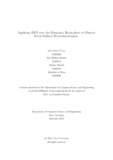| dc.contributor.advisor | Parvez, Mohammad Zavid | |
| dc.contributor.author | Khan, Akif Ahmed | |
| dc.contributor.author | Bastob, Abu Wakkas | |
| dc.contributor.author | Ahmed, Bushra | |
| dc.contributor.author | Reza, Abdullah Al | |
| dc.date.accessioned | 2020-03-08T05:22:49Z | |
| dc.date.available | 2020-03-08T05:22:49Z | |
| dc.date.copyright | 2019 | |
| dc.date.issued | 2019-12 | |
| dc.identifier.other | ID 15301100 | |
| dc.identifier.other | ID 15301071 | |
| dc.identifier.other | ID 19341010 | |
| dc.identifier.other | ID 15101060 | |
| dc.identifier.uri | http://hdl.handle.net/10361/13834 | |
| dc.description | This thesis is submitted in partial fulfillment of the requirements for the degree of Bachelor of Science in Computer Science, 2019. | en_US |
| dc.description | Cataloged from PDF version of thesis. | |
| dc.description | Includes bibliographical references (pages 33-37). | |
| dc.description.abstract | Although keeping us alive is arguably the most important function of the human
brain, the human brain is responsible for a host of functions|including processing
of environmental stimuli. Electroencephalography (EEG) is a psychophysiological
technique used to measure electro-cortical activity in the brain. It is a noninvasive
technique that provides a direct measure of the brain's electrical activity through
placement of electrodes on the scalp which is quite precise and instantaneous. A
set of probes or electrodes are placed on the scalp which receive EEG signals or
brain waves. Using EEG signals we may analyze the mechanisms behind language,
cognition, sensory functions, and brain oscillations. After gathering the eeg signals,
it can be used as a neurofeedback - a process by which eeg signals are again applied
to the brain with the same electrodes. By applying neurofeedback of some speci c
pattern or feature we can enhance those features and reduce the other features.
Transcarnial Direct Current Stimulation (tDCs) is also another non-invasive method
of neuromodulation which is used to constatly apply a small amount of electric
current on the head with the use of electrodes. With adequate amount of training
with neurofeedback, tdcs individuals may learn to control their own brain waves and
thus changing their state of self at will. We have initiated a system where we use
EEG-based neurofeedback and tDCs on the left hemisphere of the brain and observe
Event-related desynchronization occuring on the right hemisphere. After applying
ve-fold cross validation method of classi cation we acquired an accuracy of 86.67%
for anodal stimulation and 88.33% for cathodal stimulation. | en_US |
| dc.description.statementofresponsibility | Akif Ahmed Khan | |
| dc.description.statementofresponsibility | Abu Wakkas Bastob | |
| dc.description.statementofresponsibility | Bushra Ahmed | |
| dc.description.statementofresponsibility | Abdullah Al Reza | |
| dc.format.extent | 37 pages | |
| dc.language.iso | en | en_US |
| dc.publisher | Brac University | en_US |
| dc.rights | Brac University theses are protected by copyright. They may be viewed from this source for any purpose, but reproduction or distribution in any format is prohibited without written permission. | |
| dc.subject | EEG | en_US |
| dc.subject | tDCS | en_US |
| dc.subject | Neurofeedback | en_US |
| dc.subject | Cognitive Load Index | en_US |
| dc.subject | Time-Frequency distribution features | en_US |
| dc.subject | Band extraction | en_US |
| dc.subject.lcsh | Brain stimulation | |
| dc.subject.lcsh | Brain--Diseases--Diagnosis | |
| dc.subject.lcsh | Electroencephalography | |
| dc.title | Applying tDCS over the dominant Hemisphere to observe event-related Desynchronization | en_US |
| dc.type | Thesis | en_US |
| dc.contributor.department | Department of Computer Science and Engineering, Brac University | |
| dc.description.degree | B. Computer Science | |

